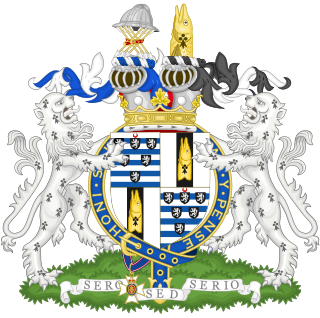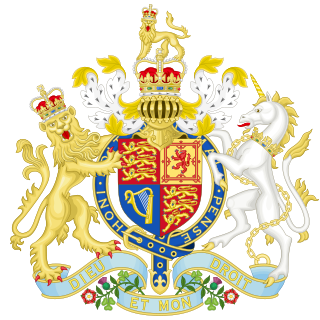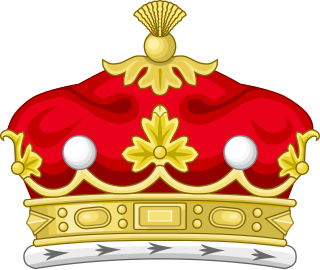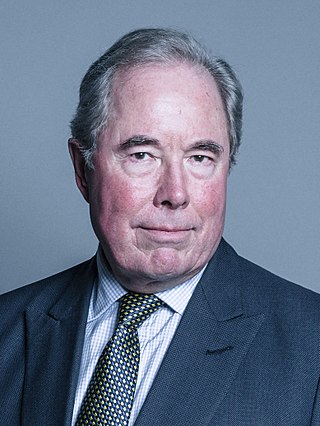Related Research Articles

Peerages in the United Kingdom form a legal system comprising both hereditary and lifetime titles, composed of various ranks, and within the framework of the Constitution of the United Kingdom form a constituent part of the legislative process and the British honours system. The British monarch is considered the fount of honour and is notionally the only person who can grant peerages, though there are many conventions about how this power is used, especially at the request of the British government. The term peerage can be used both collectively to refer to the entire body of titled nobility, and individually to refer to a specific title. British peerage title holders are termed peers of the Realm.

Marquess of Salisbury is a title in the Peerage of Great Britain. It was created in 1789 for the 7th Earl of Salisbury. Most of the holders of the title have been prominent in British political life over the last two centuries, particularly the 3rd Marquess, who served three times as Prime Minister in the late 19th and early 20th centuries.

The Peerage Act 1963 is an Act of the Parliament of the United Kingdom that permits women peeresses and all Scottish hereditary peers to sit in the House of Lords and allows newly inherited hereditary peerages to be disclaimed.

The Lord Great Chamberlain of England is the sixth of the Great Officers of State, ranking beneath the Lord Privy Seal but above the Lord High Constable. The office of Lord Great Chamberlain is an ancient one, being first created circa 1126 in Norman times and in continuous existence since 1138. The incumbent is Rupert Carington, 7th Baron Carrington.

The House of Lords Act 1999 is an Act of the Parliament of the United Kingdom that reformed the House of Lords, one of the chambers of Parliament. The Act was given Royal Assent on 11 November 1999. For centuries, the House of Lords had included several hundred members who inherited their seats ; the Act removed such a right. However, as part of a compromise, the Act allowed ninety-two hereditary peers to remain in the House. Another ten were created life peers to enable them to remain in the House.

Marquess of Cholmondeley is a title in the Peerage of the United Kingdom. It was created in 1815 for George Cholmondeley, 4th Earl of Cholmondeley.
The hereditary peers form part of the peerage in the United Kingdom. As of August 2023, there are 805 hereditary peers: 30 dukes, 34 marquesses, 189 earls, 110 viscounts, and 442 barons.
In the United Kingdom, life peers are appointed members of the peerage whose titles cannot be inherited, in contrast to hereditary peers. Life peers are appointed by the monarch on the advice of the prime minister. With the exception of the Dukedom of Edinburgh awarded for life to Prince Edward in 2023, all life peerages conferred since 2009 have been created under the Life Peerages Act 1958 with the rank of baron and entitle their holders to sit and vote in the House of Lords, presuming they meet qualifications such as age and citizenship. The legitimate children of a life peer appointed under the Life Peerages Act 1958 are entitled to style themselves with the prefix "The Honourable", although they cannot inherit the peerage itself. Prior to 2009, life peers of baronial rank could also be so created under the Appellate Jurisdiction Act 1876 for senior judges.

David George Philip Cholmondeley, 7th Marquess of Cholmondeley,, styled Viscount Malpas from birth until 1968, and subsequently Earl of Rocksavage until 1990, is a British peer and filmmaker who acted as Lord Great Chamberlain of the United Kingdom from 1990 to 2022.

George Horatio Cholmondeley, 2nd Marquess of Cholmondeley, PC, styled Viscount Malpas until 1815 and Earl of Rocksavage between 1815 and 1827, was a British peer and Lord Great Chamberlain of England between 1830 and 1838. Before being called to the House of Lords, he was a Tory Member of Parliament from 1817 through 1821.

William Henry Hugh Cholmondeley, 3rd Marquess of Cholmondeley, styled Lord Henry Cholmondeley from 1815 until 1870, was a British peer and Conservative Member of Parliament.

Nicholas Le Poer Trench, 9th Earl of Clancarty, 8th Marquess of Heusden, is an Anglo-Irish peer, as well as a nobleman in the Dutch nobility. Lord Clancarty serves as an elected Crossbench hereditary peer in the British House of Lords. His earldom is in the Peerage of Ireland.
By-elections to the House of Lords occur when vacancies arise among seats assigned to hereditary peers due to death, resignation, or disqualification. Candidates for these by-elections are limited to holders of hereditary peerages, and their electorates are made up of sitting Lords; in most cases the electorate are those sitting hereditary peers of the same party affiliation as the departed peer.
Nancy Jane Marie Heathcote-Drummond-Willoughby, 28th Baroness Willoughby de Eresby, is an English peer and member of the Astor family. She is a 1⁄4 holder of the office of Lord Great Chamberlain, which is exercised by the 7th Baron Carrington.

John Richard Boyle, 15th Earl of Cork and 15th Earl of Orrery is a British hereditary peer and a member of the House of Lords, where he sits as a Crossbencher. Boyle was an officer in the Royal Navy and then had a career in the sugar industry before inheriting his titles in 2003.

Rupert Francis John Carington, 7th Baron Carrington,, is a British banker, hereditary peer and crossbench member of the House of Lords.
Elections of the excepted hereditary peers were held in October and November 1999, before the House of Lords Act 1999 excluded most hereditary peers from the membership of the House of Lords allowing Earl Marshal, Lord Great Chamberlain and 90 others to remain in the House. Before the passing of the 1999 Act, the Lords approved a Standing Order stating that those 90 would consist of:

In the United Kingdom, the Great Officers of State are traditional ministers of the Crown who either inherit their positions or are appointed to exercise certain largely ceremonial functions or to operate as members of the government. Separate Great Officers exist for England and Wales, Scotland, and formerly for Ireland, though some exist for Great Britain and the United Kingdom as a whole.
References
- ↑ "Hansard, Vol 604 No 126 Cols 1290–1292". 26 July 1999. Retrieved 19 May 2008.
- ↑ Cracknell, Richard (15 June 2000). Lords Reform: The interim House – background statistics; Research Paper 00/61 (PDF). House of Commons Library. Retrieved 29 August 2014.
- ↑ David Boothroyd. "House of Lords Act: Hereditary Peers Elections". United Kingdom Election Results. Archived from the original on 21 January 2013. Retrieved 9 December 2016.
- ↑ "Hereditary Peers' By-election" (PDF). 7 February 2011. Retrieved 29 May 2016.
- ↑ "Office Of Lord Great Chamberlain". Parliamentary Debates (Hansard) . House of Lords. 6 May 1902. Archived 2021-01-28 at the Wayback Machine
- ↑ Great Officers of State: The Lord Great Chamberlain and The Earl Marshal Archived 6 January 2014 at the Wayback Machine . The Royal Family. debretts.com Archived 2019-08-24 at the Wayback Machine . Debrett's Limited. Accessed 17 September 2013.
- ↑ "House of Lords, Official Website – Eal of Oxford and Asquith" . Retrieved 9 September 2019.
- ↑ "House of Lords, Official Website – Viscount Falkland" . Retrieved 5 April 2012.
- ↑ "Earl Peel". UK Parliament. Retrieved 6 August 2018.
- ↑ "Lord Inglewood". UK Parliament. Retrieved 6 December 2018.
- ↑ "Duke of Wellington". UK Parliament. Retrieved 9 September 2019.
- ↑ "Earl of Selborne". UK Parliament. Retrieved 9 September 2019.
- ↑ "UKIP members in the House of Lords". ukipderbyshire.co.uk. Archived from the original on 21 March 2012. Retrieved 25 March 2011.
- ↑ "Lord Willoughby de Broke". UK Parliament. Retrieved 6 December 2018.